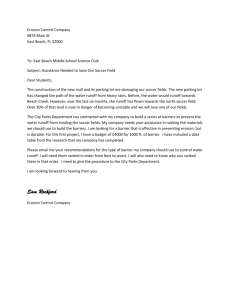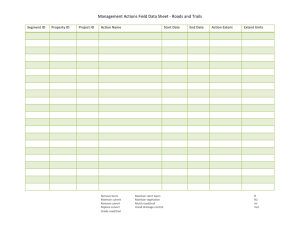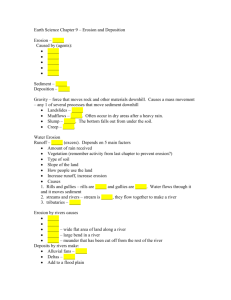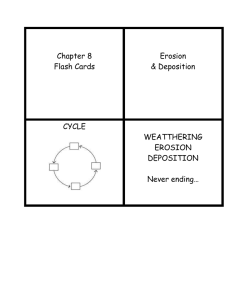X - Low Impact Development Center
advertisement
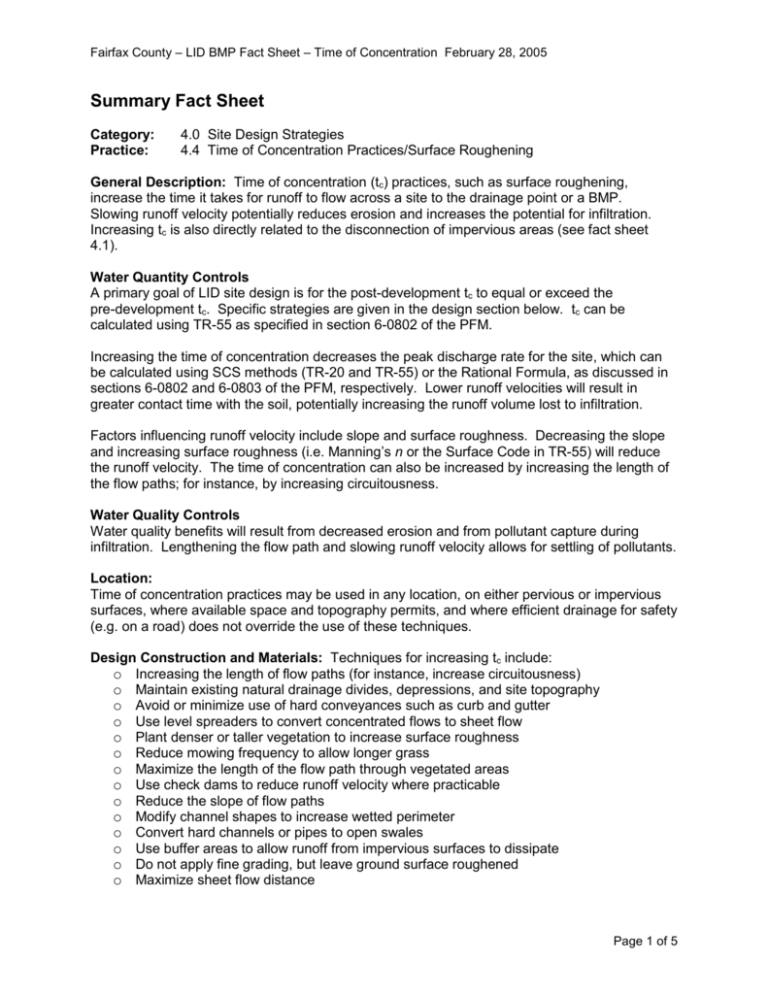
Fairfax County – LID BMP Fact Sheet – Time of Concentration February 28, 2005 Summary Fact Sheet Category: Practice: 4.0 Site Design Strategies 4.4 Time of Concentration Practices/Surface Roughening General Description: Time of concentration (tc) practices, such as surface roughening, increase the time it takes for runoff to flow across a site to the drainage point or a BMP. Slowing runoff velocity potentially reduces erosion and increases the potential for infiltration. Increasing tc is also directly related to the disconnection of impervious areas (see fact sheet 4.1). Water Quantity Controls A primary goal of LID site design is for the post-development tc to equal or exceed the pre-development tc. Specific strategies are given in the design section below. tc can be calculated using TR-55 as specified in section 6-0802 of the PFM. Increasing the time of concentration decreases the peak discharge rate for the site, which can be calculated using SCS methods (TR-20 and TR-55) or the Rational Formula, as discussed in sections 6-0802 and 6-0803 of the PFM, respectively. Lower runoff velocities will result in greater contact time with the soil, potentially increasing the runoff volume lost to infiltration. Factors influencing runoff velocity include slope and surface roughness. Decreasing the slope and increasing surface roughness (i.e. Manning’s n or the Surface Code in TR-55) will reduce the runoff velocity. The time of concentration can also be increased by increasing the length of the flow paths; for instance, by increasing circuitousness. Water Quality Controls Water quality benefits will result from decreased erosion and from pollutant capture during infiltration. Lengthening the flow path and slowing runoff velocity allows for settling of pollutants. Location: Time of concentration practices may be used in any location, on either pervious or impervious surfaces, where available space and topography permits, and where efficient drainage for safety (e.g. on a road) does not override the use of these techniques. Design Construction and Materials: Techniques for increasing tc include: o Increasing the length of flow paths (for instance, increase circuitousness) o Maintain existing natural drainage divides, depressions, and site topography o Avoid or minimize use of hard conveyances such as curb and gutter o Use level spreaders to convert concentrated flows to sheet flow o Plant denser or taller vegetation to increase surface roughness o Reduce mowing frequency to allow longer grass o Maximize the length of the flow path through vegetated areas o Use check dams to reduce runoff velocity where practicable o Reduce the slope of flow paths o Modify channel shapes to increase wetted perimeter o Convert hard channels or pipes to open swales o Use buffer areas to allow runoff from impervious surfaces to dissipate o Do not apply fine grading, but leave ground surface roughened o Maximize sheet flow distance Page 1 of 5 Fairfax County – LID BMP Fact Sheet – Time of Concentration February 28, 2005 o Follow disconnection strategies outlines in fact sheet 4.1 When applying these practices, select and modify flow paths that are representative of the actual flow pattern(s) through the drainage area. For example, if a drainage shed is predominantly an asphalt parking lot, surface roughening or tc lengthening practices should be applied to the parking lot surface because that conveys most of the flow. Increasing the length of the grass on the perimeter of the parking lot, in this case, would have a negligible effect on the overall travel time through the drainage shed if the parking lot itself is not modified. Careful soil preparation during construction can impact long-term plant vitality. Per Virginia Erosion and Sediment Control Handbook (VESCH) standards, 3:1 slopes or steeper must have surface roughening prior to vegetation establishment. Shallower slopes must have “light” roughening and the top 2 to 4” of the soil must be loose before seeding. Soil amendments can be used to increase permeability (see fact sheet 5.1). Stone check dams may be constructed in existing engineered channels to reduce runoff velocity and trap sediment. The elevation of the center of the check dam must be 6” lower than the elevation of the outer edges in order to prevent runoff from flowing through the stone-soil interface and potentially causing erosion (VESCH). The outlet area below level spreaders must have a slope shallower than 10% and be uniform and well-vegetated. The 20’ of channel upstream of the level spreader must have a 1% slope or less. The depth and length of the level spreader is determined per VESCH standards, based on the magnitude of the 10-year peak discharge. To minimize the chance of erosion in vegetated channels, keep the maximum runoff velocity below 2 to 4 feet per second, depending on slope and vegetation type (PGDER 1999). Because of the variety of methods for increasing tc, materials, construction techniques, and labor requirements vary widely. In general, key cost components are grading and earthwork and concrete construction. The price range for common components is as follows: Item Unit Estimated unit cost (2005 dollars) Excavation C.Y. $8 - $10 Grading S.Y. $0.10 - $0.15 Reinforced concrete construction (3000 psi) C.Y. $125 - $175 Vegetation planting Ea. $5 - $20 Grass seeding M.S.F. $15 - $20 Coarse aggregate C.Y. $30 - $35 Stone for check dams Ton $18 - $25 Cost: The cost to install time of concentration practices to treat runoff from ½ impervious acre is comprised of both the installation cost and annualized costs. Time of concentration practices are assumed to have a lifespan of 25 years, at which point they will be removed and replaced. Page 2 of 5 Fairfax County – LID BMP Fact Sheet – Time of Concentration February 28, 2005 Item Required Cost per Year (2005 Dollars) 1 2 3 4 5 6 7 8 9 10 Debris Removal and Weeding 250 250 250 250 250 250 250 250 250 250 Replace Vegetation or Reseed 200 200 200 200 200 200 200 200 200 200 Installation1 0 Annualized Cost 25 8,000 Remove & Replace Total Cost … 8,000 8,000 450 450 450 450 450 450 450 450 450 450 8,000 $750 / year (includes replacement in year 25) 1 Developer Cost. Not included in annualized cost. Maintenance: Level spreaders may be critical to the operation of BMPs such as bioslopes that require inflow to be sheet flow. During scheduled inspection of these BMPs, inspect the level spreader for signs of erosion, bypass, or channel formation, and repair accordingly. Long-term plant maintenance is critical. If the tc was calculated assuming a dense, tall cover of grasses, for instance, they should be maintained as such. Use organic fertilizers if necessary to maintain plant vitality. Reseed or replant dead or diseased vegetation that is located in the flow path, and use matting or other stabilization in disturbed areas. Inspect sediment buildup behind check dams several times per year and remove sediment when the accumulated height is half of the check dam height. Also, periodically inspect that the elevation of the center of the dam is lower than that of the edges, and correct if necessary. Performance and Inspection: The success of tc lengthening practices can be measured by how closely the post-development tc matches the pre-development tc. Inspect the tc lengthening practice(s) for indicators of whether the site design is handling flows as intended. The storm event being observed should be comparable to the design storm used to design the flow paths, however, because flow patterns will vary according to the intensity and rainfall volume of a given storm event. Signs that maintenance is needed include: o Concentrated flow where sheet flow was intended o Bypass or shortcutting of circuitous flow paths o Evidence of erosion or sediment transport Perform this inspection annually in late spring. Regrading and soil stabilization may be necessary to fix shortcutting problems. If erosion is observed, tc may need to be further decreased or additional soil stabilization is necessary. A healthy grass cover (where applicable) will stabilize the soil, trap sediment, and reduce runoff velocity. Inspect grassed areas for signs of disease and erosion. Perform this inspection annually in late spring. Reseed and stabilize soil as necessary. Page 3 of 5 Fairfax County – LID BMP Fact Sheet – Time of Concentration February 28, 2005 Cross-section of level spreader with rigid lip Source: Virginia Erosion and Sediment Control Handbook, Third Edition. Vegetated swale used to increase tc Source: PG DER. Potential LEED Credits: Primary: N/A Other: Innovation & Design Process (1-4 Points) Links to Additional Information: Fairfax County Department of Public Works and Environmental Services. 2001. “Hydrologic design.” Public Facilities Manual. Available at http://www.co.fairfax.va.us/dpwes/publications/pfm/6-0800.htm Prince George’s County Department of Environmental Resources (PGDER). 1999. “Low-impact development site planning.” Low-Impact Development Design Strategies: An Integrated Design Approach. Page 4 of 5 Fairfax County – LID BMP Fact Sheet – Time of Concentration February 28, 2005 Virginia Department of Conservation and Recreation. 1992. “3.21 Level Spreader.” Virginia Erosion and Sediment Control Handbook, Third Edition. Available at http://www.dcr.state.va.us/sw/docs/eschnbk/Chapter%203%20-%203.21.pdf Virginia Department of Conservation and Recreation. 1992. “3.20 Rock Check Dams.” Virginia Erosion and Sediment Control Handbook, Third Edition. Available at http://www.dcr.state.va.us/sw/docs/eschnbk/Chapter%203%20-%203.20.pdf Virginia Department of Conservation and Recreation. 1992. “3.29 Surface Roughening.” Virginia Erosion and Sediment Control Handbook, Third Edition. Available at http://www.dcr.state.va.us/sw/docs/eschnbk/Chapter%203%20-%203.29.pdf Page 5 of 5
